

The Erie County town of Tonawanda lies on the northern edge of the city of Buffalo, in the western part of New York State. It is bounded on the north by the city of Tonawanda and on the east by the town of Amherst. The town, located on the Niagara River, was primarily developed after World War II with single-family residences.
The Office of Community Development was the lead agency in development of the Tonawanda Consolidated Plan. In addition to 23 specific agencies listed, participation in the plan included contact with 105 department heads, civic groups, realtors, and churches located within the town. Advice was sought from local governments, not-for-profit and for-profit groups, and other organizations interested in affordable housing issues. Development began with three meetings in the winter of 1993. A public hearing was held on November 21, 1994, followed by meetings in December and January to discuss coordination. A summary was published in the Record Advertiser on January 11, 1995. Public notice of availability of the draft plan was also posted in public places.
Location and an abundant supply of low-cost water and electric power from hydroelectric plants in the Niagara Falls area have shaped the development of the town of Tonawanda. Niagara River access to Lake Erie and the international shipping of the St. Lawrence Seaway has made the area a hub for railroad, shipping, and modern highways. Four vehicular bridges connect the town with Canada. There is a balance of industrial, commercial, and residential development in the area, and the economic base of the town was built upon manufacturing related to the automobile and transportation industries. Several major plant closings in the 1970s and 1980s, however, sent shock waves through the area, as employment dropped disproportionately in well-paying precision production, machine operations, and transportation jobs. While the town's unemployment rate had come back down to 4.4 percent by 1990, it remained at 16 percent in Parkside Village.
In 1990 the town of Tonawanda's population was counted at 82,464 (9.6 percent fewer persons than in 1980). Decreases in population were found in older neighborhoods, but population increases have occurred in newer, developing areas. The town covers an area of approximately 18.9 square miles. One in every five persons was elderly (age 60 or older) -- a 24-percent increase -- and another one in five persons was younger than 18 years of age. Minorities made up only 2.5 percent of the population, and the highest minority concentration in any census tract was only 4.3 percent. Hispanics and Asian/Pacific Islanders, at 0.8 percent each, formed the largest minority groups.
Almost three-fourths of Tonawanda's 33,636 households lived in owner-occupied units, whose median value was $74,200 in 1990. Median monthly rent was $356. The cost of housing during the 1980s escalated faster than median household income, which reached $31,078 in 1990. Based on the 1990 Erie County MSA median family income of $35,061, nearly one-third of the families residing in the town were low- and moderate-income (less than 80 percent of MSA median family income). One in eight town families was very low-income (50 percent or less). Low-income families were concentrated in the "urban areas" of Tonawanda. In general, statistically, the average resident within the town of Tonawanda has been marginally better off financially than the typical resident of the Erie County MSA, as the median family income is $1,900 higher in the town.

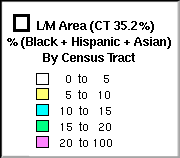
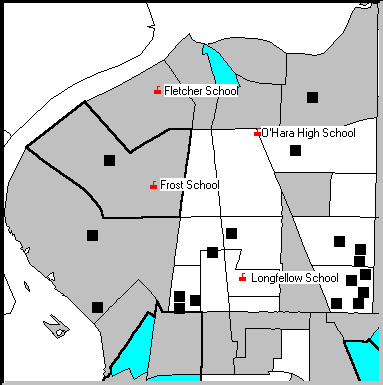
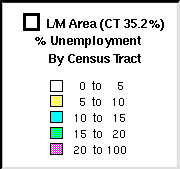
About 20 percent of the housing stock in Tonawanda is more than 50 years old, while only 8 percent has been built since 1970. About 12 percent of the rental units and 5 percent of the owner-occupied units need rehabilitation. Less than 100 of the 35,016 existing year-round units are in condition that is not considered suitable for rehabilitation. Preservation and upgrade of the older housing stock is a priority in order to stabilize neighborhoods and keep housing affordable. New construction and substantial rehabilitation is of lesser priority because of the cost of new construction and the general condition of the housing stock. However, the HOME Programs Substantial Rehabilitation option was used successfully and will be a model for additional rehabilitation projects in the future.
The housing market is tight in the town of Tonawanda. The vacancy rate for renters is 3.8 percent; for homeowners it is 0.4 percent. The town is essentially built-up, with only a few lots actually available for construction.
Rental housing constitutes approximately 30 percent of the housing stock. Most of the rental units are in two-family or multifamily (five or more) units. Large apartment complexes provide over 40 percent of the rental housing available. Only one-fifth of rental units have more than two bedrooms. Approximately 57 percent of rental units are not affordable to low-income households.
Ninety-one percent of the owner-occupied and for-sale housing is single-family structure (typically three-bedroom) housing. Mobile homes, while still less than 1 percent of the housing stock, increased by 281 percent between 1980 and 1990. The average cost of a single-family home increased by 68.6 percent between 1985 and 1991. Newly constructed houses are generally listed between $125,000 and $175,000. Rising home prices have made purchase of a home increasingly less affordable for many residents.
Approximately 36 percent of all renter households paid more than 30 percent of their household income for housing. The greatest need for affordable housing is among extremely low-income (under 30 percent of the median income) renters; 71 percent of this group spent more than half of their income for housing. Most of the need is among small families. Elderly households represent 60 percent of the total low-income housing need in the town. There are 373 households on the Section 8 Existing Rent Assistance Program waiting list. New applicants will have a minimum wait of 5 years for a rent certificate or voucher. Securing additional rental assistance must be a top priority of the 5-year strategy.
Half of extremely low-income homeowners spent more than 50 percent of their income for housing. Most of these homeowners also have other housing problems and are in danger of becoming homeless. About 12 percent of owner households earning between 31 and 50 percent of the median family income pay more than half of their income for housing.
The town has used the Community Development Block Grant (CDBG) program to implement a 5-year housing and infrastructure program in Parkside Village Courts directed at redeveloping this 70-percent low-income neighborhood. Five miles of infrastructure have been improved and over 430 rental units have been rehabilitated.
Public and private nonprofit agencies operate supportive housing in the town of Tonawanda for persons with mental retardation and developmental disabilities, youth, and the mentally ill who are substance abusers. A total of 234 beds of supportive housing and a 40-person outpatient service capacity are available for these special population groups. Comprehensive planning for special needs persons is currently being done and must be given high priority.
The growing population of elderly includes the young-old, who are healthy and not interested in relocating; the transitional elderly (between 75 and 84 years old), who prefer to age in place but may need assistance with housing costs; and those 85 and older, most of whom prefer to age in place but desire in-home services. The 85 and older group increased by 30 percent between 1980 and 1990. It is estimated that 722 very low-, low-, and moderate-income elderly owner and renter households live in inadequate structural housing conditions.
Assessing needs of the homeless in the town is complicated by the fact that the homeless tend to gravitate to the services in Buffalo and adjacent communities and are less visible in the town of Tonawanda. Emergency Shelter Grants awarded the town of Tonawanda have been used by emergency shelters in the town and in the city of Buffalo to upgrade their facilities and expand their services. Only one shelter is located within the town because very few homeless have been found on the street.
The homeless are a heterogeneous group that require a range of services including affordable housing. An extensive list of services for the homeless in the county has been prepared. The needs of homeless women and children in the town are particularly acute. Haven House, a domestic violence shelter, was unable to shelter 1,377 women with 1,880 children who called for help in 1993. More shelter space and transitional housing is needed.
The Kenmore Public Housing Authority operates 200 public housing units for the elderly, whose income must not exceed 80 percent of median. The 100 midrise units in Kenmore Village Apartments opened in 1975. Theater Apartments, constructed in 1985, includes 10 units for the disabled elderly. Both buildings are well-maintained, but there is need to modify two elevators and to make some energy conservation and sprinkler system improvements. Both buildings have tenant organizations that meet regularly. There are 345 persons on the waiting list.
In addition, the town lists 779 Section 202/Section 8 assisted housing units, 1,105 rental rehabilitation units, and 700 units of assisted supportive housing units. Of these, 45 units are for disabled persons and 1,065 units are for elderly persons.
A review of relevant policies has identified several tools available to governmental units that would increase housing affordablility. Tax exemptions may be made for housing for affordable housing projects, for special population groups including the elderly, for energy conservation, and for resource conservation. After this review, it was determined that current zoning ordinances and fees are necessary to ensure a reasonably durable infrastructure, are not discriminatory, and do not constitute barriers to housing affordability. In general, the town has an atmosphere that is receptive to the production, maintenance, and improvement of affordable housing.
Discrimination, however, creates obstacles for poor renter households. Discrimination due to familial status, religion, national origin, sex, marital status, disability, and age is not prohibited by law in owner-occupied two-family dwellings, which comprise a significant portion of the area's rental stock. Discrimination due to lawful source of income is not prohibited in most of Erie County.
It has been estimated that 2,335 Tonawanda housing units -- including 770 occupied by extremely low- and very low-income persons -- have a lead-based paint hazard. The Erie County Health Department sponsors a Lead Poisoning Prevention Program that has a close working relationship with the town Board of Commissioners. The program annually inspects nearly 2,000 residences throughout the county and provides direct assistance in all cases where a child has a lead count of 20 or higher. No instances of noncompliance by landlords or homeowners have been reported following court intervention.
It has been estimated that there are now 400-650 cases of AIDS in the Buffalo area, and that an increase to 700-800 AIDS cases by 1998 is a real possibility. Persons with HIV/AIDS will probably require increasing housing and supportive services.
The 5-year strategic plan identifies the programs and resources for implementing the Consolidated Plan and provides a discussion of the institutional structure and public policies required to successfully implement housing priorities. A number of overriding themes were presented under which critical housing needs in the town of Tonawanda could be grouped:
Priority #1:
Programs under this priority include rehabilitating 54 low-income, owner-occupied units per year through the CDBG program; weatherizing 35 low-income, owner-occupied units per year through the Weatherization Assistance Program; demolishing and rebuilding 3 severely deteriorated low-income, owner-occupied houses each year using HOME and CDBG funds; rehabilitating 9 low-income rental units over 5 years using New York State Rental Rehabilitation Program and CDBG funds; and rehabilitating and modernizing public housing as identified yearly.
Priority #2:
Programs under this priority over the next 5 years include securing Section 8 rental assistance for 250 additional low-income households; adding 50 units for low-income elderly though the Section 202 program; adding 50 units for the elderly of Section 8 New Construction; and assisting 150 elderly households by providing a Section 8 Existing certificate or voucher and supportive services.
Priority #3:
Depending upon which Federal program is in effect, 10 emergency shelters or homeless services will be assisted on a countywide basis and 60 families or individuals in imminent danger of becoming homeless will be directed to the Housing Assistance Center over the next 5 years.
Under this priority, 30 homeless families/individuals will be assisted to secure permanent, affordable housing using Section 8 certificates/vouchers, and 250 persons will be assisted in a housing/service facility for mentally ill substance abusers.
The long-term objective of the town's community development focus is to prevent or ameliorate deterioration in neighborhoods. Infrastructure improvements may include the installation of new and/or replacement of deteriorated curbs, streets, sidewalks, fire hydrants, storm drainage, sanitary sewers, water mains, trees, and traffic signs. This approach acknowledges the integrity of neighborhoods and the interaction of infrastructure and housing. In the short term, the town will review older neighborhoods and monitor conditions for use of CDBG funds. Public facilities improvements will focus on systematic updating of the extensive park/recreation system with special emphasis on needs of the changing age structure of the population. Accessibility will be assessed. Public service needs will be addressed by establishing satellite police stations to increase police/neighborhood contact. There is also a need to coordinate efforts to use energy conservation measures as a way of reducing housing costs.
Where appropriate and feasible, the town of Tonawanda will coordinate its housing programs with services designed to assist low-income households in breaking the cycle of poverty. Actions planned include:
Coordination among governmental entities was initiated by the town prior to, and has continued during, the process of developing the Consolidated Plan. Local communities, including Erie County, the city of Buffalo, and surrounding towns and villages, have participated in numerous meetings and planning sessions to lay the groundwork for implementation. Some of the services planned will be delivered by nonprofit organizations including Supportive Services, Inc., Housing Assistance Center of Niagara Frontier, Inc., Belmont Shelter Corporation, and emergency shelter/homeless service providers. Public/private partnerships will be established to achieve goals.
Monitoring will be achieved through contracts with subrecipients. Onsite reviews will be conducted annually.
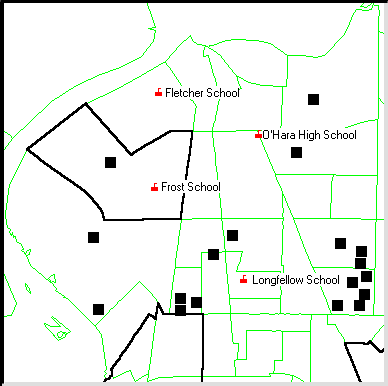
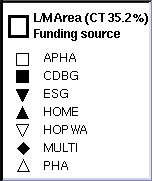
The action plan for the 1995 fiscal year follows the programs and priorities listed above. The priorities focus on rehabilitation of low-income renter and owner units; demolition and replacement of a few severely deteriorated units; weatherization; rental assistance for low-income, elderly, and special needs populations; improvements in infrastructure and public facilities; and services to prevent homelessness. Testing and abatement for lead-based paint hazards will continue. Thirty-three CDBG projects have been identified using approximately $2,788,000.
Each of the geographic areas in the town selected for CDBG and HOME program funds are similar in that they are older neighborhoods and exhibit signs of aging infrastructure, streets, housing, and park facilities. These neighborhoods suffer from problems that can be improved when funds are strategically applied.